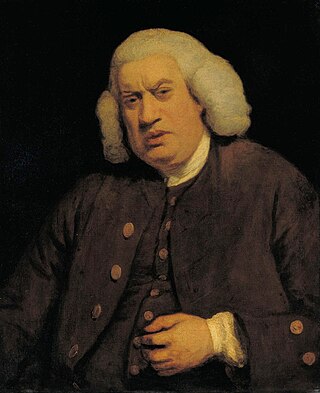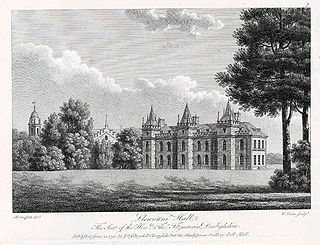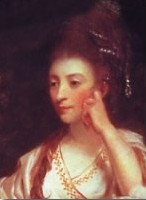Related Research Articles

Samuel Johnson, often called Dr Johnson, was an English writer who made lasting contributions as a poet, playwright, essayist, moralist, literary critic, sermonist, biographer, editor, and lexicographer. The Oxford Dictionary of National Biography calls him "arguably the most distinguished man of letters in English history".

Dorothea Jordan was an Anglo-Irish actress, as well as a courtesan. She was the long-time mistress of Prince William, Duke of Clarence, and the mother of 10 illegitimate children by him, all of whom took the surname FitzClarence. She was known professionally as Dorothea Francis and Dorothea Jordan, was informally Dora Jordan, and she commonly was referred to as Mrs Jordan and Mrs FitzClarence.

Hester Lynch Thrale Piozzi, a Welsh-born diarist, author, socialite and patron of the arts, is an important source on Samuel Johnson and 18th-century English life. She belonged to the prominent Salusbury family, Anglo-Welsh landowners, and married first a wealthy brewer, Henry Thrale, with whom she had 12 children, then a music teacher, Gabriel Mario Piozzi. Her Anecdotes of the Late Samuel Johnson (1786) and her diary Thraliana, published posthumously in 1942, are the main works for which she is remembered. She also wrote a popular history book, a travel book, and a dictionary. She has been seen as a protofeminist.

Henry Thrale was a British politician who sat in the House of Commons from 1765 to 1780. He was a close friend of Samuel Johnson. Like his father, he was the proprietor of the large London brewery H. Thrale & Co.
Sir John Salusbury Piozzi Salusbury was a British civil servant and, briefly, a military officer during the Battle of Waterloo. He was named after his adopted grandfather, Sir John Salusbury.

Lleweni Hall was a stately home in Denbighshire, northeast Wales, around 2 miles (3.2 km) north-east of Denbigh on the banks of the River Clwyd. It was the principal seat of the Salusbury family and their descendants from 1289 until 1748, and the present territorial designation of the most senior branch of the family.
This article is about the particular significance of the decade 1780–1789 to Wales and its people.

The Thraliana was a diary kept by Hester Thrale and is part of the genre known as table talk. Although the work began as Thrale's diary focused on her experience with her family, it slowly changed focus to emphasise various anecdotes and stories about the life of Samuel Johnson. The work was used as a basis for Thrale's Anecdotes of the Late Samuel Johnson, but the Thraliana remained unpublished until 1942. The anecdotes contained within the work were popular with Thrale's contemporaries but seen as vulgar. Among 20th-century readers, the work was popular, and many literary critics believe that the work is a valuable contribution to the genre and for providing information about Johnson's and her own life.
A Biographical Sketch of Dr Samuel Johnson was written by Thomas Tyers for The Gentleman's Magazine's December 1784 issue. The work was written immediately after the death of Samuel Johnson and is the first postmortem biographical work on the author. The first full length biography was written by John Hawkins and titled Life of Samuel Johnson.

The Plays of William Shakespeare was an 18th-century edition of the dramatic works of William Shakespeare, edited by Samuel Johnson and George Steevens. Johnson announced his intention to edit Shakespeare's plays in his Miscellaneous Observations on Macbeth (1745), and a full Proposal for the edition was published in 1756. The edition was finally published in 1765.
The health of Samuel Johnson has been a focus of the biographical and critical analysis of his life. His medical history was well documented by Johnson and his friends, and those writings have allowed later critics and doctors to infer diagnoses of conditions that were unknown in Johnson's day.

Hester Maria Elphinstone, Viscountess Keith, born Hester Maria Thrale, was a British literary correspondent and intellectual. She was the eldest child of Hester Thrale, diarist, author and confidante of Samuel Johnson, and Henry Thrale, a wealthy brewer and patron of the arts. She became the second wife of George Elphinstone, 1st Viscount Keith.
Samuel Johnson, a British intellectual, wrote dozens of essays that defined his views on the politics of his time.
Robert William Chapman, usually known in print as R. W. Chapman, was a British scholar, book collector and editor of the works of Samuel Johnson and Jane Austen.

William Seward was an English man of letters, known for his collections of anecdotes. he was closely acquainted in London with Samuel Johnson, the Thrales and the Burneys.
Susannah Dobson née Dawson was a translator from the south of England, the daughter of John Dawson of "the parish of St Dunstan, London". She was notably concerned with the 14th-century Italian humanist Petrarch.
George Squibb was a British auctioneer, succeeding his father James, who founded the auction house of Squibb & Son, and working from public rooms in Boyle Street, facing down Savile Row, London, where the elder Squibb had set up in 1778. The grand rooms had been built in the 1730s, at the time Lord Burlington was developing the second phase of his real estate venture at the end of Burlington House gardens; they were extended by Squibb with a top-lit auction room. In 1813 he sold the collection of paintings of the late Duke of San Pietro. Among the country house auctions that fell under his hammer was that of the contents of Streatham Park, sold for Hester Thrale Piozzi in May 1816. Among those associated with Squibb was Michael Bryan, the connoisseur and author of the Dictionary of Painters
Katherine Canby Balderston was an American scholar of 18th century English literature. A professor emerita at Wellesley College, she was a winner of the Rose Mary Crawshay Prize in 1941.
Marianne Francis (1790–1832) was an English evangelical, now known principally as a correspondent of Hester Piozzi and Sarah Wesley. She has been called an "evangelical bluestocking", and is recognised as a significant participant in debate about religious enthusiasm.
References
- Balderston, Katharine C. "Introduction" in Thraliana: The Diary of Mrs Hester Lynch Thrale (Later Mrs. Piozzi) 1776-1809. Vol. I ed. Katherine C. Balderston, pp. ix-xxxii Oxford: Clarendon Press, 1951.
- Bloom, Harold. "Hester Thrale Piozzi 1741-1821" in Women Memoirists Vol II, ed. Harold Bloom, pp. 74–76. Philadelphia, Chelsea House, 1998.
- Brownley, Martine Watson. "Samuel Johnson and the Printing Career of Hester Lynch Piozzi" Bulletin of the John Rylands University Library of Manchester Vol. 67, No. 2 (Spring 1985): pp. 623–640.
- Clifford, James L. "The Daily Diaries of Hester Lynch Piozzi," Columbia Library Columns Vol. 22, No. 3 (1978): pp. 10–17.
- Hill, G. Birkbeck, editor, Johnsonian Miscellanies Vol 1. Oxford, 1897.
- Piozzi, Hester Lynch. Autobiography, letters and literature remains of Mrs. Piozzi Vol II ed. Abraham Hayward. London: Longman, Green, Longman, and Roberts, 1861.
- Piozzi, Hester Lynch. Anecdotes of the Late Samuel Johnson in Johnsonian Miscellanies Vol 1. ed. Hill, G. Birkbeck, pp. 141 – 351. Oxford, 1897.
- Prior, Jam, editor Life of Edmond Malone, editor of Shakspeare : with selections from his manuscript anecdotes. London, 1860.
- Walpole, Horace. Letters Vol IX ed. Pet Cunningham. London, 1861.